March in Yellowstone: Are you thinking of visiting Yellowstone National Park in March? Yellowstone in March is still cold and the ground is covered in snow. Should you still visit Yellowstone in March? Absolutely.
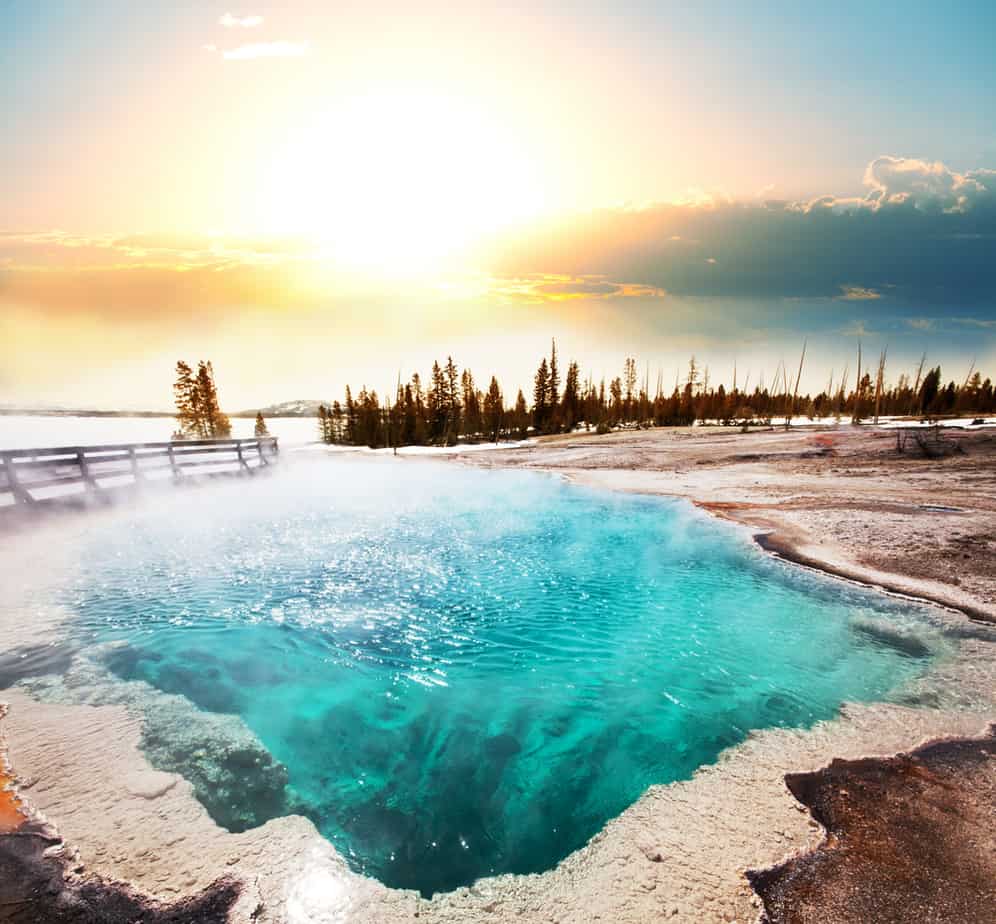
There is so much to do in Yellowstone in March especially if you want to take advantage of winter activities. If you are visiting Yellowstone in March make sure you are well prepared. The weather changes daily so you have to be ready for everything.
In March only parts of Yellowstone will be accessible. Some of the roads in the north of the park are closed. This is why an organized tour is a good idea. Especially a winter walking tour through the park.
Thank you for supporting this website written by an American. This post may contain affiliate links. This means I earn a small commission on these links at no extra cost to you.
National Park Entrance Fees
To enter the National Parks, you’ll need to pay an entrance fee or have a National Parks Pass also known as American the Beautiful Pass.
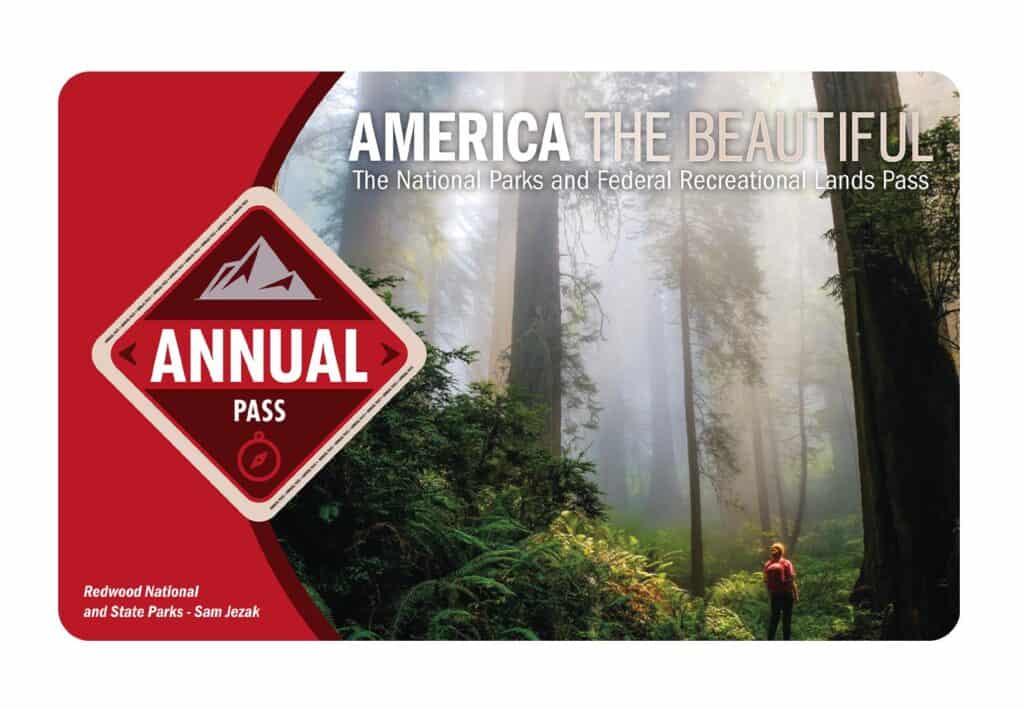
It costs $80 for a yearly America the Beautiful Pass. This gives you access to all national parks and federal areas that charge fees. The America the Beautiful Pass is well worth it!
I purchased my first one in 2016 and it’s such a money-saver! Plus 10% of sale proceeds go to the National Park Foundation.
Tips for Visiting Grand Teton National Park
Grand Canyon National Park is perfect for outdoor enthusiasts. There is something for everyone on this list and for different fitness levels. Also, note that it is dry and hot (in the summer), and make sure you know what you are getting into before you start. Here are a few tips for visiting the Grand Canyon:
- Bring a reusable water bottle and lots of water! Remember you are in the sun and you will need to drink lots of water. I love my LifeStraw Filtered Water Bottle. I can refill this bottle anywhere and it comes with a carabiner to connect it to my daypack.
- Check the Weather – days over 100 degrees are very common. Make sure to check.
- Hiking boots or sandals that will protect your feet! I love good shoes. I need all the support and help I can get. I actually love these sandals for hiking and also love these hiking boots.
- Bring hiking poles for balance and to protect your knees. I know many experienced hikers (and even amateur ones) think that hiking poles are for old people who lose their balance. Actually, hiking poles can help when going down steep inclines or when scrambling over rocks. They are great to hike with even for the most experienced hiker.
- Wear a sunhat. I feel like this whole post is about how high you are in the mountains and how much closer you are to the sun but it is so true. At elevation, you are closer to the sun and more likely to burn. Wear sun protection such as a sun hat and sunscreen.
- Be aware of the wildlife. This is the Southwest and you will need to watch out for snakes and other wildlife such as moose or a bear. Please stay away from wildlife and do not feed them. I recommend carrying bear spray as well.
- Start Early – If you want to avoid the traffic and the heat you will need to start your hike early. That way it will be nice and cool and the smog will not affect you either.
- Leave no trace. If you are new to the concept of Leave No Trace it is all about preserving the environment to ensure it is in the same or better condition when you leave it. This means that you should stick to the trails and carry out everything that you carried in. This is a great explanation of the Leave No Trace principles!
- Water shoes are great for water hikes– If you don’t have a pair, I highly suggest it as they are affordable. I have an article on the pros and cons of several pairs of water shoes.
- Bring Bug Spray and a snack: Be sure to bring everything you need including a snack like a protein bar plus BUG SPRAY.
Where to stay near Grand Canyon National Park
The Grand Canyon makes for a great weekend escape. Fresh air, beautiful scenery and being in nature does a world of good for the soul. I recommend staying as close to the park as possible and even treating yourself with a cabin with a spa pool to relax at night.
- There are lots of fantastic Airbnbs near the Grand Canyon. I have made a list of the best airbnbs around the park wherever you decide to stay. You can also check out my post on Where to Stay near the Grand Canyon to find the perfect hotel for any budget.
If you are taking a road trip remember to reserve a car in advance using Discover Cars .
Yellowstone Weather in March
Yellowstone in the winter is not for the faint of heart. During this time of year, the park gets a huge amount of snow, and the temperature rarely rises above freezing during the day.
If you do decide to travel during this time of year, make sure you have all of the necessary safety equipment with you, including snow tires, maps, booster cables, sleeping bags, flashlights, first-aid kits, shovels, and extra food and water.
During March, the weather in Yellowstone is often chilly and snowy. Mammoth Hot Springs has an average temperature of 5 degrees Celsius and a low of 5 degrees Celsius.
The average temperature at Old Faithful is 31 degrees Fahrenheit with a low of 2 degrees Fahrenheit. In March, Yellowstone gets an average of 8 days of snow or 25 inches of snow.
15 Things to do in Yellowstone in March
Yellowstone is open 365 days a year 24 hours a day. In March, the only gates that are open are the northern gate in Gardiner, Montana to the Northeast gate in Cooke City.
This gate is open year round and you can visit Mammoth Springs and the Lamar Valley. Otherwise you can visit the park on foot, snowshoeing, snowmobiling, or skiing. Only 32,000 people visit Yellowstone in March.
You can only visit Old Faithful by guided tour or on foot.
Canyon Visitor Education Center Lobby
Enter the Canyon Visitor Education Center and the realm of Yellowstone’s supervolcano, a concept that has captivated people all over the world.
At the Center, you can see, hear, and understand how Yellowstone’s volcano, geysers, and hot springs, as well as the region’s geologic past, affect the distribution and quantity of all species. Interactive exhibits, animations, audio-visual productions, and real-time scientific data are used to explore these concepts.
You can also learn more about the area’s geology and see a room-size Yellowstone relief map. You can also get information about the park, pick up a backcountry or fishing permit, buy souvenirs, learn about ranger activities and see a 20-minute film.
Restrooms are also open 24 hours a day here.
Self-Driving Audio Guided Tour
While driving around in the car you can listen to the history of Yellowstone. With this all-in-one tour, audio guide, and map, you’ll get the most out of Yellowstone.
Discover the towering geysers, prismatic hot springs, and incredible wildlife that have captured the American imagination at your own pace.
With your audio guide, make your way around the Grand Loop. Along the way, marvel at wonderful areas of interest and hear the interesting stories and history of this fascinating location, as well as additional text and video to bring each stop to life.
Learn how to get up and personal with legendary geysers like Old Faithful and also watch hot water jets emerging from the soil and learn about the geological science behind them.
You can also visit Grand Prismatic, a boiling hot spring, and see vibrant color bands, bubbling paint pots like Fountain, and glistening waterfalls like Gibbon Falls.
Allow your expert audio guide to accompany you as you explore the wildlife and natural wonders of this magnificent location. This audio tour is the best way to learn more about Yellowstone.
Mammoth Hot Springs
Mammoth Hot Springs is a must-see attraction in Yellowstone National Park because they are unlike any other thermal location in the vicinity.
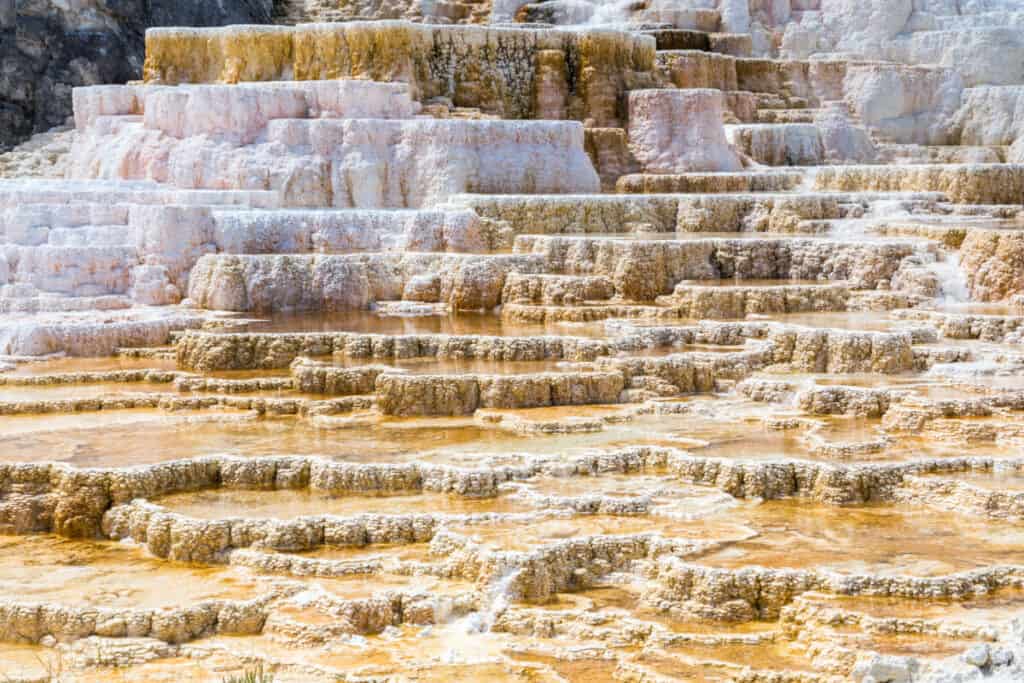
This is because limestone is a relatively soft rock, allowing travertine forms to grow significantly more quickly than other sinter formations. It’s been likened to a cave that’s been turned inside out.
The hot, acidic solution dissolves enormous amounts of limestone in the Mammoth area as it rises through the rock layers to the surface hot springs.
The Pinedale Glaciation left a lot of evidence of glacial activity in the Mammoth area. The Terrace Mountain’s peak is covered in glacial till indicating that the travertine production there precedes the end of the Pinedale Glaciation.
The Mammoth Village area is home to several thermal kames, including Capitol Hill and Dude Hill. In the short, narrow valleys where Floating Island Lake and Phantom Lake are found, ice-marginal stream beds can be seen. The Gardner River’s ancient, sorted gravel bed is covered by unsorted glacial till in Gardner Canyon.
Mammoth Hot Springs is located just south of Yellowstone’s North Entrance (near Gardiner, Montana).
The location is accessible by car throughout the year. Around the Upper and Lower Terraces, boardwalks stretch for roughly 1.75 kilometers. The easy hike should take approximately an hour (there are just about 300 feet of elevation gain).
Visit Old Faithful Geyser – only through a Guided Tour
Immerse yourself in Yellowstone National Park’s beauty and wildlife. On your trip from West Yellowstone, learn about its history from your guide, see the many magnificent vistas it has to offer, and have a delicious lunch.
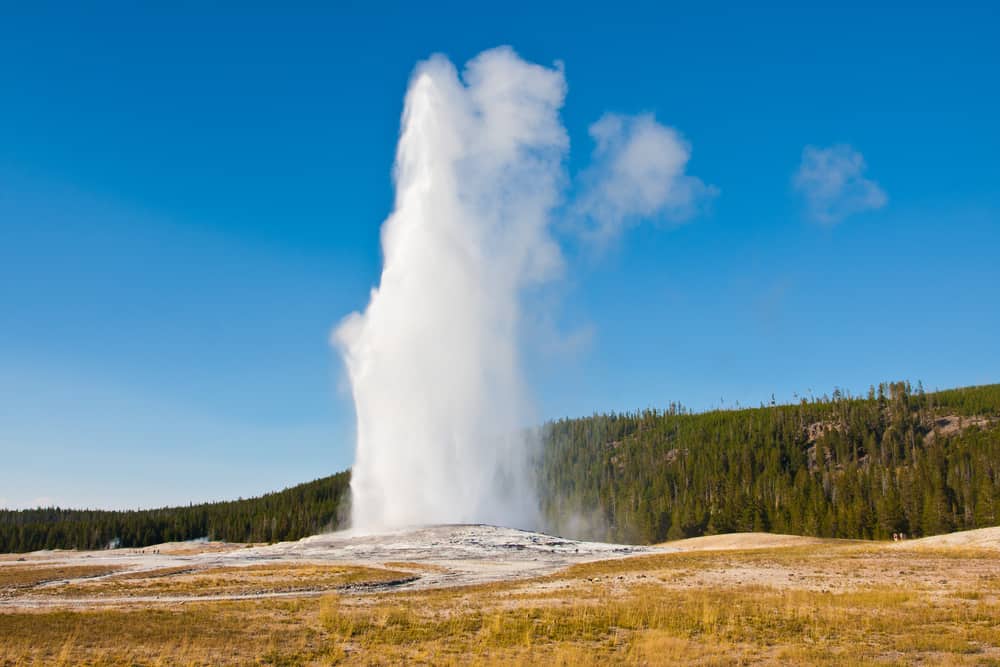
It’s a Yellowstone National Park tradition to see Old Faithful Geyser erupt. People have traveled from all over the world to see this famous geyser.
Although the park’s animals and landscape are well-known today, it was the park’s distinctive thermal features, such as Old Faithful Geyser, that prompted its designation as the world’s first national park in 1872.
Old Faithful is one of Yellowstone’s almost 500 geysers, and one of six that park rangers expect to explode shortly. It’s rare to be able to anticipate geyser outbursts with any degree of accuracy, but Old Faithful has held good to its name in the last 30 years, only increasing the duration between eruptions by around 30 minutes.
Depart West Yellowstone, Montana, and enter Yellowstone National Park via the West Gate. Tour the Lower Loop, stopping at Old Faithful and the Geyser Basins, among other places. The Grand Prismatic Spring, Fountain Paint Pots, Artist Point, the Grand Canyon of Yellowstone, and Hayden Valley are also among the sights to see.
Moreover, watch eruptions from the Old Faithful viewing area or along the boardwalks that weave around the geyser and through the Upper Geyser Basin.
West Thumb Geyser Basin
West Thumb Geyser Basin is one of Yellowstone National Park’s most beautiful areas, located near the shores of Yellowstone Lake.

West Thumb’s delights sometimes elude guests searching for the commotion and bustle of sites like the Upper Geyser Basin or Fountain Paint Pots, the quieter and cleaner counterpart to the east half’s other major basin—Mud Volcano. However, for those seeking a more introspective Yellowstone experience while still admiring Yellowstone’s various thermal richness, West Thumb Geyser Basin reigns supreme.
West Thumb was once treated as a lunch spot in the Park’s early days, praised for its proximity to Lake Hotel. Visitors may eat lunch at the lunch station, tour the sites, and then take a stage or a steamer around the lake. West Thumb became more well-known as a stopping point for travelers arriving by car later on.
Collapsing Pool which is surrounded by ridges of gray rock and Blue Funnel Spring whose remarkable pastel hue makes it an incredible stunner are two of the most beautiful ponds along this walk.
The best part is West Thumb is comparatively uncongested.
Full-Day Yellowstone Lower Loop Tour
This full-day tour starts in Jackson, Wyoming, and travels north through Grand Teton National Park to Yellowstone National Park. This is a fully guided, interpretive, road-based tour of Yellowstone National Park’s Lower Loop.
On the Lower Loop, you’ll see the Upper Geyser Basin, which includes Old Faithful, the Midway Geyser Basin, the Firehole Lake Loop, and many others. Several short hikes along the many boardwalks within the geyser basins, as well as to the Upper and Lower Falls of the Yellowstone River, are available during the day.
The area is rich in wildlife, as well as the beautiful scenery and spectacular thermal characteristics that have made Yellowstone famous.
This is a small-group tour with a maximum of 8 people aboard. The tour is conducted in a clean and safe late-model vehicle, and the guides are professionals.
Also included is a delicious, freshly prepared picnic lunch.
Lamar Valley
Lamar Valley, more than any other location in Yellowstone, offers the best chance of seeing wild bison.
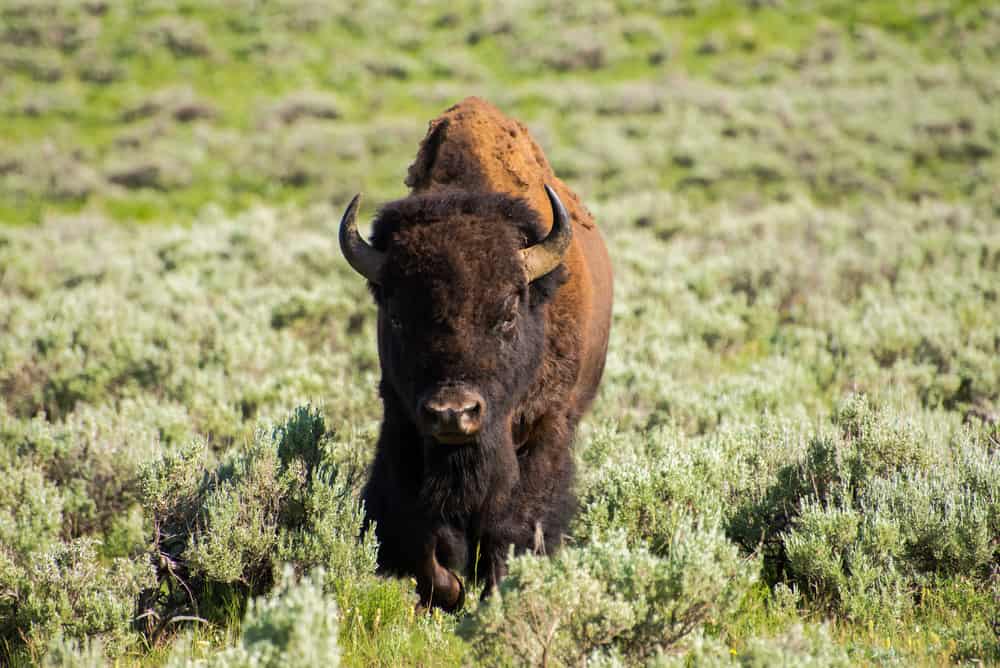
The Lamar River feeds a large grassy valley in Yellowstone National Park’s northeast section, attracting massive grazers. The Lamar Valley Bison Herd is nearly always visible from Route 212 which goes down the valley through various views.
The Junction Butte and Lamar Canyon wolf packs are among its most famous inhabitants; wolf enthusiasts gather with spotting scopes most days in the hopes of seeing these majestic canines in action. Large herds of bison, pronghorn, badgers, grizzly bears, bald eagles, osprey, deer, and coyotes are among the creatures that wander the Lamar. If you observe any active wildlife, keep your eyes out for pullouts along the road and park in the nearest one.
Another popular pastime in Lamar Valley is fishing in the Lamar River. If you want to do more than just look at the wildlife, you’ll need a fishing license. Yellowstone National Park also charges an admission fee.
Join a local guide for a chance to see bears, wolves, bison, pronghorn, and other animals. Relax in a spacious van with large windows and soak in the sights of the Lamar Balley’s wildlife.
Cross-country Ski Tours and Trails
Yellowstone has some fantastic cross-country skiing trails in the winter. During the winter, cross-country skiing and snowshoeing are permitted on all of Yellowstone’s unplowed roads and trails.
There are 40 miles of cross-country trails in the Old Faithful region alone, several of which are interconnected. Drop-offs from the Old Faithful Snow Lodge to the Divide or Fairy Falls trailheads are available, but you must return to your skis.
Stay on marked trails if you’re unfamiliar with the Yellowstone area. Concessionaires in the park offers guided ski tours and shuttles. The Yellowstone Association Institute’s Winter Wonderland program on snow coach, snowshoes, and skis is a popular tour.
Snowmobiling
From the 608-mile Continental Divide Snowmobile Trail in western Wyoming to the several trails out of West Yellowstone, Montana, the “Snowmobiling Capital of the World,” Yellowstone Country has some of the best snowmobile trails in the country.
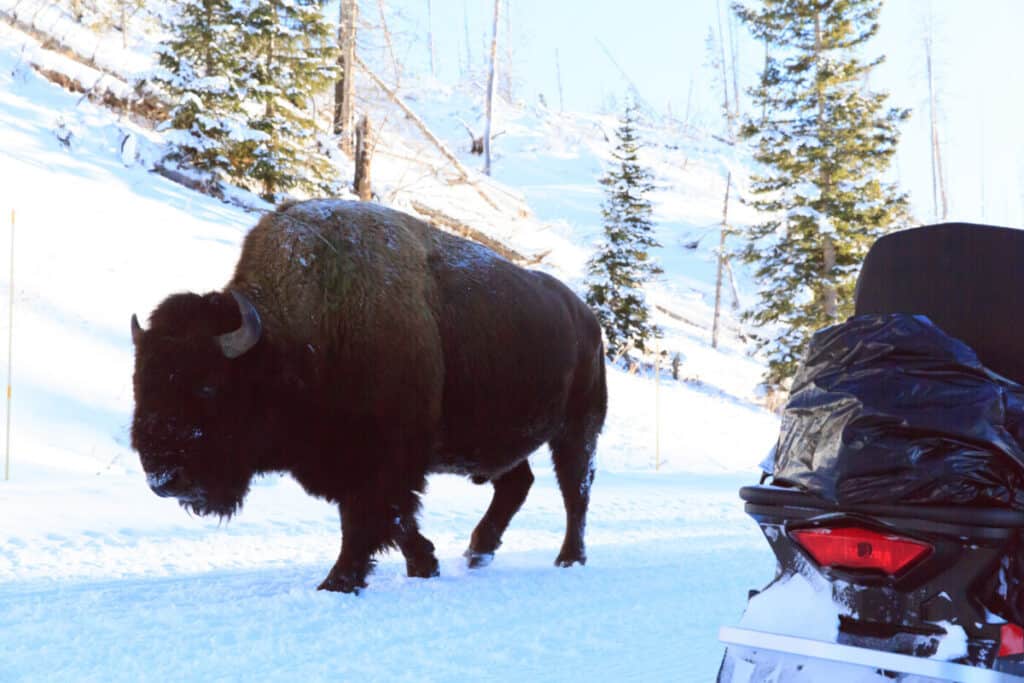
On National Forest Service land, snowmobile over 300 miles of groomed tracks or play in the deep and steep snow-covered mountains. The City Center Motel has plenty of trailer parking and vehicle plug-ins.
Riding your snowmobile, renting one from a local outfitter, or going guided are all available. Each day, a limited number of snowmobile parties are permitted to enter Yellowstone National Park.
Sleigh Rides
The National Elk Refuge, a 24,700-acre sanctuary between Jackson, Wyoming, and Grand Teton National Park, is home to up to 7,000 elk during the winter months.
When the ground is covered with snow, you may see them up close from the comfort of a horse-drawn sleigh or one of these top three sleigh rides near Yellowstone and Grand Teton on the Teton mountain range’s west side.
Before boarding the sleigh, guests at Mountain River Ranch are greeted with cider or hot chocolate. During the ride, you’ll sing along to seasonal carols, and afterward, you’ll be treated to a real Old West holiday entertainment and a prime rib feast.
Additionally, before your sleigh ride, La Belle Lake Lodge allows you to walk through ice corridors, slide down ice slides, and perch on an ice throne. Under the warmth of a warm blanket, you’ll visit the local llamas and observe the horses being served their dinner.
Wolf Watching Tours
Have you always wanted to see Yellowstone’s most elusive major predator? There’s no better time to see these magnificent creatures than in the winter when their dark coats contrast with the white snow. For the best chance to see a wolf, go on a wolf-watching tour.

The Winter Wolf and Wildlife Safari, a two-day tour to Yellowstone’s northern range, is provided by Yellowstone Safari Company. Participants will have a long evening hunting for wolves before having an early start the following morning.
If you’re going for a longer trip, Wolf Tracker offers five-day trips that include Wolf Watches in Gardiner, Montana, and a Wolf Retreat in Bozeman. He’s a Yellowstone native who’s studied wolf and elk ecology, and a researcher and conservationist, so outings are led by a knowledgeable team.
Take a dip in a hot spring
Even in the wintertime, Yellowstone’s Boiling River meets the Gardner River near Mammoth, generating a series of soak-friendly pools. To get to the unique area, use the half-mile trail from the 45th Parallel Bridge.
The park’s bison herd is in residence, and the indoor Bath House remains open, making winter a great time to visit Hot Springs State Park in Thermopolis, Wyoming.
Stay at the Fairmont Hot Springs Resort, which is located north of Yellowstone National Park. Their hot springs pool has a water slide and is open 24 hours a day.
Canyon Yurt Camp
Canyon Yurt Camp offers skiers and snowshoers a true wilderness experience while also providing all of the amenities of a remote wilderness resort.
The Nordic ski guides take you on magnificent cross country ski tracks to explore the Grand Canyon of the Yellowstone River, backcountry hot springs, wildlife viewing, and spectacular icy winter landscape, while the camp crew cooks delicious meals.
In March, the Yurt Camp is the only place to stay in Yellowstone, and it’s set in a small meadow surrounded by coniferous forest.
This cozy and remarkably comfortable camp, located less than one kilometer from the Grand Canyon and Yellowstone River Falls, provides access to renowned places such as the upper Yellowstone River, which is an established wildlife corridor, as well as the Hayden Valley, Norris Geyser Basin, and Gibbon Meadows. The location, which sits at a height of 2425 meters (8,000 feet), is one of pristine beauty that takes on an otherworldly feel in the winter.
Guests can relax in the amenities of a fully equipped, heated base camp, which includes private heated sleeping huts and a shared dining room Yurt. There are fully heated camp showers, a sauna, and heated (and well-lit) restrooms, elevating the degree of comfort far above that of a typical winter camping experience.
You should see no other people for over 50 kilometers because you are the only accommodation in the center of Yellowstone throughout the winter!
Fishing Bridge RV Park
Fishing Bridge has a rich history of being a favorite lake fishing. Since the bridge was a significant spawning place for cutthroat trout, angling from it was excellent.
Near the mouth of the Yellowstone River as it departs Yellowstone Lake lies the Fishing Bridge Recreational Vehicle Park. The Fishing Bridge, a wooden vehicle bridge that used to provide a magnificent platform from which park visitors could fish for native Cutthroat trout, inspired the name of the RV park.
Fishing is no longer permitted from the bridge, although visitors still congregate on the walkways to observe White Pelicans and other waterfowl skimming across the river’s surface, as well as to search for trout swimming beneath the crystal-clear water.
New and larger sites, a larger parking lot, a new dump station and recycling area, and an expanded registration building with extra bathrooms and laundry facilities are all part of the renovation.
The Fishing Bridge RV Park will have 310 hard-sided recreational vehicle-only campsites. This is due to the RV park’s proximity to bear habitat. Based on the availability of the right-size site, recreational vehicles with a combined length of up to 95 feet (RV and tow vehicle) can be accommodated. The majority of the sites are open, with a combination of pull-through and back-in alternatives.
Madison Campground
The Madison River, which runs through the area in a lush mountain landscape rich in animals, is named for the campground. Madison Campground is placed in a mostly wooded area at an elevation of 6,800 feet, offering a choice of generally sunny to mostly shaded sites. The area is recognized for its excellent fishing and handy location concerning Old Faithful, the Upper, Midway, and Lower Geyser Basins.
There are more than 270 individual sites and three group sites to choose from. RVs and tents are welcome at the campground and there are also other campsites for hikers and cyclists. A picnic table and a fire grate are provided at each site and the places are close to a water source.
Pull-through and back-in sites may accommodate RVs up to 40 feet long. Campers should plan properly because the sites may not be level. While there are no utility hookups at the sites, the park does include an RV dump station. Due to freezing weather, the dump station may be unavailable early and late in the season.
This campground is in a great location for a variety of activities and sights. You can try fishing near the Madison River.
Moreover, the Firehole Canyon Drive is not far away, where you can see the Firehole Falls. Lower Geyser Basin and the Fountain Paint Pots are also only a short drive away.
Conclusion: Visiting Yellowstone in March
In March, Yellowstone is usually still covered in snow. Many species of wildlife can be found at lower elevations, where they can be seen for hours.
The best reason to visit in March is to see the wildlife. Because the high terrain is too chilly in the winter, most animals migrate to the meadows and valleys. Bison, bighorn sheep, pronghorn, wolves, and elk are abundant in Yellowstone’s valleys, thanks to the large concentration of species at lower elevations.
The lack of crowds is another benefit of visiting in March. Even though it is transitioning into spring, it is still rather cold. Because there are fewer people in the park, you may be able to enjoy the serenity.
Many lower-elevation trails are open in the winter, providing excellent opportunities for snowshoeing and cross-country skiing. To prepare for your vacation, read about all of the paths that are open for snowshoeing or skiing in the winter. You can also join one of the many guided skiing and snowshoeing trips offered in the area if you want to learn more about the park’s heritage. In March, wildlife viewing is also fascinating and plentiful in the park.
Recent Posts
15 Tips for Visiting the Grand Canyon in September – 2023 Ultimate Guide
Visiting the Grand Canyon in September is a great time to visit. September is a busy time to visit but the crowds are starting to arrive especially toward the end of the month. I’ve included...
15 Tips for Visiting the Grand Canyon in August – 2023 Ultimate Guide
Visiting the Grand Canyon in August is a great time to visit. August is a busy time to visit but the crowds are starting to arrive especially toward the end of the month. I’ve included all...
